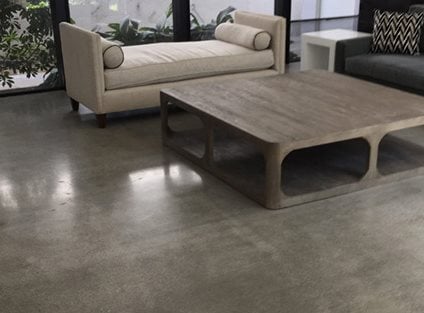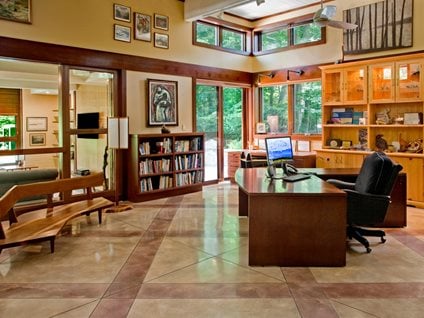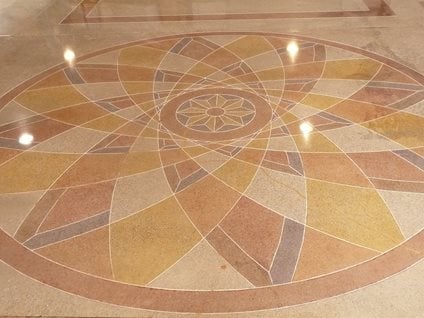Economical: You can expect to pay between $3 and $12 per square foot for polished concrete, depending on your location and the complexity of the project. Polished concrete pricing is dependent upon how many levels of grinding are needed to get the floor to a smooth surface. The cost for polished concrete can go up depending upon decorative effects that are applied such as staining or scoring.
Find concrete polishing contractors near me
HOW MUCH IS IT TO POLISH CONCRETE FLOORS?
The best way to find out what you'll pay, is to get quotes for your project. But, here are some general price ranges to help you start figuring out your budget.

Basic: $3 to $5 per square foot
An economical choice that might include:
- One layer and color of stain
- Ground and polished to a moderate shine
- Minimal surface preparation

Mid-Range: $5 to $8 per square foot
This range allows you to add some customization:
- Two colors of stain
- Simple scoring pattern or other simple design element
- Glossier finish
- More extensive surface preparation

High-End: $8 to $12 and up per square foot
Custom elements and extensive design options are included in this range, such as:
- Multiple stain colors or custom color matches
- Elaborate designs, patterns, or stencils
- Hand-applied staining details
- Extensive grinding and surface preparation
These price ranges are for grinding, polishing, and decorative elements applied to existing concrete. Installing new concrete would be in addition to the price ranges shown above.
Looking for a more affordable alternative to polishing? Check out burnished concrete, which achieves a similar looking floor.
Here are more details about the factors that contribute to the final cost:
- Gloss or shine level: The level of shine determines the number of steps in the polishing process-the glossier the finish, the more steps-which translates into higher cost.
- Area: The total square footage obviously translates to the total overall cost, but the price per square foot can be considerably less for larger spaces.
- Number of rooms: Multiple rooms equates to more edges and doorways to work around, the use of smaller handheld equipment, and increased labor costs.
- Current flooring: If the current flooring needs to be removed, that adds to the cost of the project. It also has some effect on the surface preparation costs. For instance, if a floor is currently carpeted or covered with linoleum, there will be glue that needs to be removed. Thinset that is used under tiled surfaces needs to be ground before polishing.
- Condition of existing surface: Cracks, holes, and gouges in the existing surface need to be repaired before the surface can be ground and polished. Stains also need to be dealt with, and in some cases if the required repairs are extensive, an overlay may be needed before polishing. Extensive surface prep can add an additional $2 per square foot.
- Design elements: The extent of design has the greatest impact on the price per square foot. From simply polishing plain gray concrete to elaborate custom designs, nearly anything is possible.
- Floors above grade: Plan on adding an additional $2 to $3 per square foot to install polished floors on raised decks or subfloors, as waterproofing and cement underlayment will be needed first.
Commercial vs residential
Polished concrete cost tends to be more economical with large commercial spaces, such as warehouses or retail shops. Because they are wide open areas, larger equipment can be used and there are fewer obstacles to work around. Smaller residential floors tend to be higher in price because of the need for smaller equipment and getting into smaller spaces.
POLISHED CONCRETE VS. OTHER FLOORING MATERIALS
Basic polished concrete is often less expensive than installing other flooring options. In addition to being cheaper initially to install, there is also a huge difference in long-term costs when it comes to maintenance and replacement.
Polished concrete requires minimal maintenance (regular dust mopping and occasional damp mopping) and can last a lifetime. Other surfaces, such as carpet, require more frequent deeper cleanings and may need replacement in as little as 8 to 10 years.
Polished concrete vs. tile?
Ceramic tile does offer a wide variety of design options, has a good lifespan, and fairly easy maintenance-other than cleaning grout lines. The initial cost, however, can be 4 times (or more) higher than installing polished concrete.
Polished concrete vs. hardwood?
Generally, your color options are limited to shades of brown, with some newer wood flooring options available in whitewashed or grey tones. The durability is lower than polished concrete, as the surface can be scratched or dented. Wood and laminate flooring can be damaged by water and harbor mold or mildew. Basic polished concrete can cost half as much, or less, than installing hardwood flooring.
Polished concrete vs. epoxy?
Epoxy coatings compare similarly to basic or mid-range polished finishes in cost, as well as in durability and ease of maintenance.
Learn more about how polished concrete compares to other flooring options.
DIY POLISHED CONCRETE: CAN I DO IT MYSELF?
With the rise in popularity of the industrial look, concrete flooring is becoming more and more common. And while you can readily find articles and videos that show you how to do it yourself, we don’t recommend it-and here’s why:
- Surface preparation: To get the look you want, you must make sure the surface is not only free of cracks and holes, but is also structurally sound. If you are going to apply stain, there are strict guidelines of how the surface should be cleaned and prepped for successful application.
- Equipment: Grinding and polishing equipment can be costly to rent. It also takes skill to get a flat surface with a uniform finish from edge to edge. Incorrect use of the equipment can leave permanent marks in the surface.
- Design options: If you’re looking for anything other than plain gray, staining and other design elements are best left to the pros. Any number of things can go wrong: from bad or inconsistent coloring due to poor surface prep to permanent mistakes made when scoring a design.
If mistakes are made, they are likely permanent. At that point, you’d need to install an overlay and start over or abandon your dream of polished floors and install another flooring option on top.
Learn more about the cost of interior concrete floors.